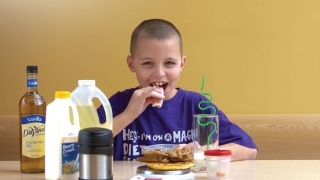Today, 9-year-old Korey Walton’s lunch is three small logs of cream cheese wrapped in deli ham, a glass of 6 percent heavy cream fortified with canola oil, and two Goldfish crackers.
He grimaces as he slurps the last few drops of pure oil through a straw, but he eats it all without complaint. This strange diet has given him his life back.
 Korey has epilepsy, one of the most common brain disorders in children, but his treatment is unusual: a diet of exactly 90 percent fat, 7 percent protein and 3 percent carbohydrates. It’s called the ketogenic diet — similar to an extreme version of the Atkins diet — and it has proven surprisingly effective for children whose epilepsy does not respond to medication.
Korey has epilepsy, one of the most common brain disorders in children, but his treatment is unusual: a diet of exactly 90 percent fat, 7 percent protein and 3 percent carbohydrates. It’s called the ketogenic diet — similar to an extreme version of the Atkins diet — and it has proven surprisingly effective for children whose epilepsy does not respond to medication.
The human body prefers to get energy from carbohydrates like those found in starchy, sugary foods, but if deprived of carbs, our bodies will burn fat for energy instead. The ketogenic diet, developed almost a century ago, essentially leaves the body in full-time fat-burning mode. As a result, the body’s chemistry changes in complex ways that help inhibit seizures.
Most patients who stick to the diet show dramatic cognitive improvement and halve their number of seizures. Medications can be reduced or discontinued. Some kids even are cured completely by the diet. But there can be no cheating: A little off-diet lick of sugar or a nibble of bread could immediately trigger a seizure.
“Seventy percent of children with epilepsy can control their seizures with medication,” says Christina Bergqvist, MD, director of the Dietary Treatment Program at CHOP. “But once a medication stops working, the chances that any of the other standard epilepsy drugs will work becomes quite small.”
When that happened for Korey, and he was experiencing as many as 50 seizures a day, Bergqvist recommended the ketogenic diet. Although wary of the amount of work, the Waltons were willing to try. Without it, Korey was at the mercy of the seizures, which could strike at any time, causing severe headaches, blanking out and other difficulties.
Beginning the Ketogenic diet
Korey was admitted to CHOP for five days while Bergqvist, along with dietitian Cagla Fenton, RD, CDN, and nurse Claire Chee, RN, gradually shifted him onto the ketogenic diet.
Everything Korey eats is measured. He gets exactly 2,088 calories a day and takes supplementary vitamins to round out his diet. Almost every meal involves drinking heavy cream (specially donated by Wawa to CHOP families) and often stars ingredients like cream, mayonnaise, eggs, butter, nuts, soy and oil.
Restaurants, pizza parties and trips to the ice cream parlor are out of the question for “keto kids,” which is tough to handle. But Korey’s diligence is paying off. Eight months into his three-to-five-year treatment plan, he has only a few mild seizures a week and is being weaned from two medications.
“He’s much more alert, a whole different kid,” says his mother, Dawn. “We have our son back.”
Recipes, classes and support
To help families like the Waltons succeed on such a labor intensive and unusual diet, the dietary program staff provides recipes and advises them on cooking ketogenic meals for even the pickiest eaters. A handbook includes recipes for how to make waffles from ground pecans and oil, and a pizza that is 90 percent fat — one of Korey’s favorites.
“When I walked out of the class, I thought, ‘I don’t know if I can do this. I don’t know if Korey can do it,’” says Dawn. “But we make it a family affair, and it works.” As the youngest of eight, Korey has plenty of siblings supporting him and cooking his meals.
The Waltons are so grateful for the care they’ve received at CHOP, they have raised more than $26,000 from family and friends to build a kitchen at the Hospital so that parents can practice preparing meals under supervision.
The Keto Kitchen, which opened in September, is the first ketogenic kitchen in the country — made possible by the collective efforts of dozens of CHOP donors and families like the Waltons.
“It’s not just for Korey, it’s for everybody who’s going to take the same journey,” Dawn says.


